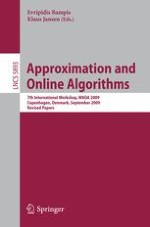2010 | Buch
Approximation and Online Algorithms
7th International Workshop,WAOA 2009, Copenhagen Denmark, September 10-11, 2009. Revised Papers
herausgegeben von: Evripidis Bampis, Klaus Jansen
Verlag: Springer Berlin Heidelberg
Buchreihe : Lecture Notes in Computer Science
